AMD Zen 2 Microarchitecture Analysis: Ryzen 3000 and EPYC Rome
by Dr. Ian Cutress on June 10, 2019 7:22 PM EST- Posted in
- CPUs
- AMD
- Ryzen
- EPYC
- Infinity Fabric
- PCIe 4.0
- Zen 2
- Rome
- Ryzen 3000
- Ryzen 3rd Gen
CCX Size
Moving down in node size brings up a number of challenges in the core and beyond. Even disregarding power and frequency, the ability to put structures into silicon and then integrate that silicon into the package, as well as providing power to the right parts of the silicon through the right connections becomes an exercise in itself. AMD gave us some insight into how 7nm changed some of its designs, as well as the packaging challenges therein.
A key metric given up by AMD relates to the core complex: four cores, the associated core structures, and then L2 and L3 caches. With 12nm and the Zen+ core, AMD stated that a single core complex was ~60 square millimeters, which separates into 44mm2 for the cores and 16mm2 for the 8MB of L3 per CCX. Add two of these 60mm2 complexes with a memory controller, PCIe lanes, four IF links, and other IO, and a Zen+ zeppelin die was 213 mm2 in total.
For Zen 2, a single chiplet is 74mm2, of which 31.3 mm2 is a core complex with 16 MB of L3. AMD did not breakdown this 31.3 number into cores and L3, but one might imagine that the L3 might be approaching 50% of that number. The reason the chiplet is so much smaller is that it doesn’t need memory controllers, it only has one IF link, and has no IO, because all of the platform requirements are on the IO die. This allows AMD to make the chiplets extremely compact. However if AMD intends to keep increasing the L3 cache, we might end up with most of the chip as L3.
Overall however, AMD has stated that the CCX (cores plus L3) has decreased in size by 47%. That is showing great scaling, especially if the +15% raw instruction throughput and increased frequency comes into play. Performance per mm2 is going to be a very exciting metric.
Packaging
With Matisse staying in the AM4 socket, and Rome in the EPYC socket, AMD stated that they had to make some bets on its packaging technology in order to maintain compatibility. Invariably some of these bets end up being tradeoffs for continual support, however AMD believes that the extra effort has been worth the continued compatibility.
One of the key points AMD spoke about with relation to packaging is how each of the silicon dies are attached to the package. In order to enable a pin-grid array desktop processor, the silicon has to be affixed to the processor in a BGA fashion. AMD stated that due to the 7nm process, the bump pitch (the distance between the solder balls on the silicon die and package) reduced from 150 microns on 12nm to 130 microns on 7nm. This doesn’t sound like much, however AMD stated that there are only two vendors in the world with technology sufficient to do this. The only alternative would be to have a bigger bit of silicon to support a larger bump pitch, ultimately leading to a lot of empty silicon (or a different design paradigm).
One of the ways in order to enable the tighter bump pitch is to adjust how the bumps are processed on the underside of the die. Normally a solder bump on a package is a blob/ball of lead-free solder, relying on the physics of surface tension and reflow to ensure it is consistent and regular. In order to enable the tighter bump pitches however, AMD had to move to a copper pillar solder bump topology.
In order to enable this feature, copper is epitaxially deposited within a mask in order to create a ‘stand’ on which the reflow solder sits. Due to the diameter of the pillar, less solder mask is needed and it creates a smaller solder radius. AMD also came across another issue, due to its dual die design inside Matisse: if the IO die uses standard solder bump masks, and the chiplets use copper pillars, there needs to be a level of height consistency for integrated heat spreaders. For the smaller copper pillars, this means managing the level of copper pillar growth.
AMD explained that it was actually easier to manage this connection implementation than it would be to build different height heatspreaders, as the stamping process used for heatspreaders would not enable such a low tolerance. AMD expects all of its 7nm designs in the future to use the copper pillar implementation.
Routing
Beyond just putting the silicon onto the organic substrate, that substrate has to manage connections between the die and externally to the die. AMD had to increase the number of substrate layers in the package to 12 for Matisse in order to handle the extra routing (no word on how many layers are required in Rome, perhaps 14). This also becomes somewhat complicated for single core chiplet and dual core chiplet processors, especially when testing the silicon before placing it onto the package.
From the diagram we can clearly see the IF links from the two chiplets going to the IO die, with the IO die also handling the memory controllers and what looks like power plane duties as well. There are no in-package links between the chiplets, in case anyone was still wondering: the chiplets have no way of direct communication – all communication between chiplets is handled through the IO die.
AMD stated that with this layout they also had to be mindful of how the processor was placed in the system, as well as cooling and memory layout. Also, when it comes to faster memory support, or the tighter tolerances of PCIe 4.0, all of this also needs to be taken into consideration as provide the optimal path for signaling without interference from other traces and other routing.


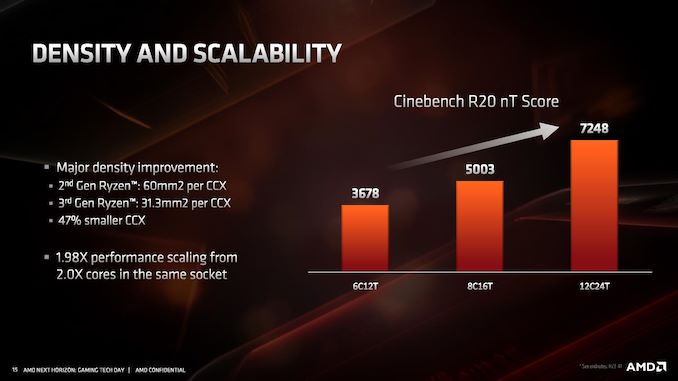
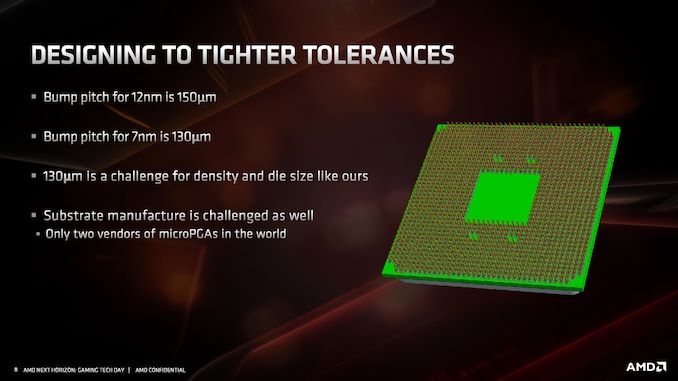
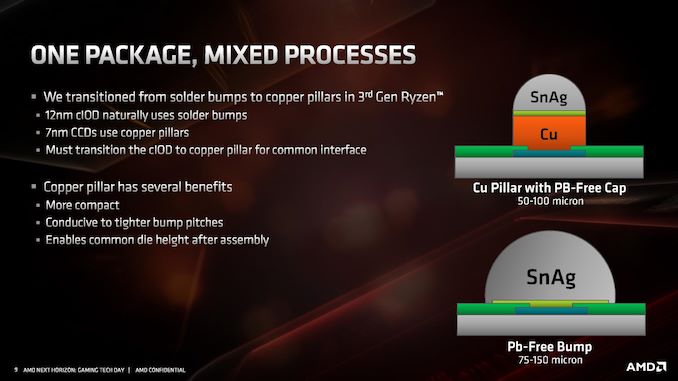
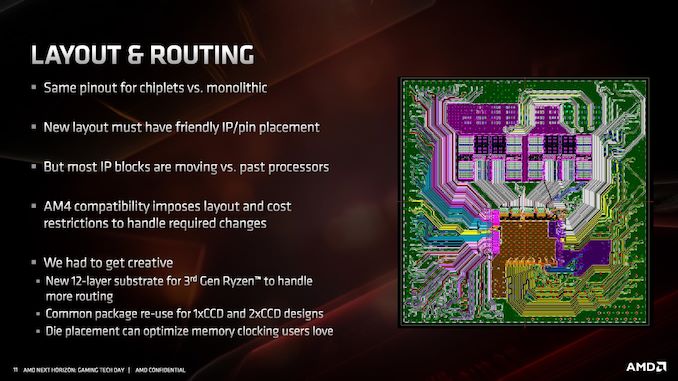
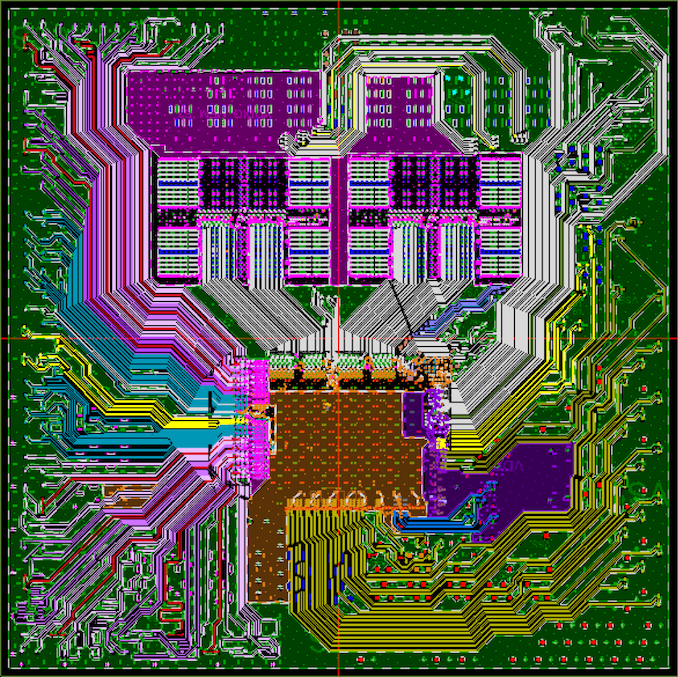








216 Comments
View All Comments
mikato - Tuesday, June 11, 2019 - link
Hehe, yeah I saw that. That was a good one for the marketing team or whoever makes the slides.Atari2600 - Wednesday, June 12, 2019 - link
No, for each of those line items they should have said "Intel only"zalves - Tuesday, June 11, 2019 - link
I really don't understand how one can compare these AMD CPU's with Intel's HEDT, they lack PCIe Lanes and don't support quad-channel memory. And that a huge deal breaker for anyone that wants and needs some serious IO and multi tasking.TheUnhandledException - Tuesday, June 11, 2019 - link
Well that is what Threadripper is for. Can't wait to see the 3000 series Threadrippers.John_M - Tuesday, June 11, 2019 - link
So, 5th generation EPYC codename is going to be either Turin, Bolognia or Florence as Palermo has already been used for Sempron.John_M - Tuesday, June 11, 2019 - link
*that's Bologna, of course. It would be nice to be able to edit posts for typos.WaltC - Tuesday, June 11, 2019 - link
Great read!John_M - Tuesday, June 11, 2019 - link
What is the advantage in halving the L1 instruction cache? Was the change forced by the doubling of its associativity? According to the (I suspect somewhat oversimplified) Wikipedia article on CPU Cache, doubling the associativity increases the probability of a hit by about the same amount as doubling the cache size, but with more complexity. So how is this Zen2 configuration better than that in Zen and Zen+?John_M - Tuesday, June 11, 2019 - link
Ah! It's sort of explained at the bottom of page 7. I had glossed over that because the first two paragraphs were too technical for my understanding. I see that it was halved to make room for something else to be made bigger, which on balance seems to be a successful trade off.arnd - Wednesday, June 12, 2019 - link
More importantly, 32K 8-way is a sweet spot for an L1 cache. This is what AMD is using for the D$ already and what all modern Intel L1 caches (both I and D) are. With eight ways, this is the largest size you can have for a non-aliasing virtually indexed cache using the 4KB page size of the x86 architecture. Having more than eight ways has diminishing returns, so going beyond 32KB requires extra complexity for dealing with aliasing or physically indexed caches like the L2.